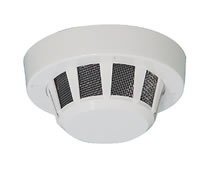Information: A smoke alarm / detector is, as the name suggests,
a device that detects smoke and raises an alarm in the event of smoke
detection. Commercial, industrial, and mass residential devices issue
a signal to a fire alarm system, while household detectors, known as
smoke alarms, generally issue a local audible and/or visual alarm from
the detector itself.
Most smoke detectors work either by optical detection (photoelectric)
or by physical process (ionization), while others use both detection
methods to increase sensitivity to smoke. Smoke detectors are usually
powered by a central fire alarm system, which is powered by the mains
with a battery backup.
Flats and houses for rent in Liverpool and Birkenhead have to meet a
series of fire-related guidelines and safeguards.
It
is advisable to install a suitable number of mains operated self-contained
smoke alarms that conform to BS 5446 Part 1 (or equivalent standard).
Each detector should have a battery backup and should be installed as
follows:
-
Where accommodation is on more than one storey, there should be at least
one alarm on each storey.
- All alarms should be interconnected so that smoke detection by one
unit activates the alarm signal in all of them.
- Smoke alarms should be positioned in circulation areas within seven
metres of doors to rooms that are at high risk from fire, such as kitchens
or living rooms and within three metres of bedroom doors. (These distances
are measured horizontally).
- Any corridor more than 15 metres long should have more than one self-contained
smoke alarm.
- Each smoke alarm should be fixed to the ceiling at least 300 mm from
any wall or light fitting, if possible in the centre of the ceiling.
- Smoke alarms designed specifically for wall-mounted use should be
fixed between 150 mm and 300 mm below the ceiling.
- Smoke alarms should not be fixed to, or directly above, heaters or
air conditioning outlets.
- Smoke alarms should not be fixed in bathrooms, showers, cooking areas
or any place where steam, condensation or fumes could set off a false
alarm. Heat detectors are a better guide to fire risks in these areas.
- Smoke alarms should be permanently wired to a separate fused circuit
at the distribution board. If battery-operated smoke alarms have already
been fitted, they are acceptable only if they comply with the instructions
given above on the minimum number per storey and interconnection so
that smoke detected by one alarm will trigger a signal in all of them.
If battery-operated smoke alarms are installed, the batteries must be
changed once a year.
- All smoke alarms (mains or battery) must be checked regularly at the
following intervals:
Monthly - test the circuit by pressing the button. Alarms should also
be tested using one of the purpose-designed testing kits that are widely
available.
Yearly
- Vacuum the inside of every smoke alarm to be prevent dust from blocking
the sensor elements. When cleaning mains-powered smoke alarms, first
make sure that they are not connected to the mains.
NOTE
Self-contained smoke alarms may not be suitable for larger dwellings.
If the distance from any part of one room to any part of another on
the same floor is more than 30 metres, the fire alarm system installed
should comply with British Standard BS 5839 (Part 6), Grade B, Type
LD2.


